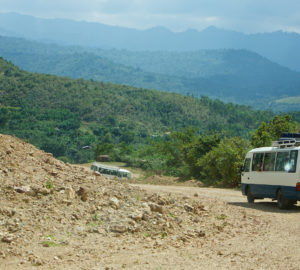What is Anaerobic Fermentation?
All coffee starts life as a fruit, and must undergo several steps of transformation in order to emerge at the end as the finished coffee we know and love. One of the first (and most critical) steps in coffee’s journey is called “processing”, an umbrella term that refers to how the ripe red fruit is removed from the coffee seed. This stage might the washing (or not), depulping, and drying of coffee at the farm, washing station, or mill. It’s through the style of processing that coffee may take on additional flavor characteristics beyond variety and terroir, due to the style in which it was handled. Some of the most popular styles of coffee processing including washed, natural, and honey process, to name just a few.
Another form of processing is called anaerobic fermentation, which refers to lack of oxygen (an-aerobic). In anaerobic processing, a producer has specifically deprived the coffee’s surrounding environment of oxygen during the fermentation stage, which can have unique effects on its ultimate flavor profile. Deprivation of oxygen can happen within a bag, vat, or other container that limits oxygen’s ability to reach the coffee as it ferments. The oxygen can be released via a one-way valve, or specifically pushed out by forcing carbon dioxide into the container (see more on this below). This allows for a longer fermentation phase to occur without the risks of overfermentation and unpleasant notes being added to the coffee, as could happen in an open environment (such as during the “natural” processing style).
How did we decide to start doing this to coffee anyway?
Anaerobic fermentation comes more or less directly from the winemaking world, where grapes are fermented within enclosed containers to attenuate temperature, oxygen, and other factors which effect grapes’ fermentation.
2015 World Barista Champion Sasa Sestic is generally credited with porting this concept from wine to coffee, after being inspired by a winemaker in his home of Canberra, Australia. At the 2015 World Barista Championship, Sestic used a rare variety of Colombian-grown coffee processed with a specific variation of anaerobic processing called carbonic maceration, in which oxygen is pushed out by CO2. Carbonic maceration is historically associated with the production of the red-fruited Gamay wines of Beaujolais, and now with contemporary wines that are lighter-bodied and fruity. You can find winemakers working in this style in nearly every corner of the winemaking world, from Oregon to Chile to New Zealand back to France, Spain, and Italy.
What is the effect of anaerobic fermentation on coffee flavor?
Erwin Mierisch of Nicaragua’s Fincas Mierisch, whose farms have been experimenting with this process since 2018, points to not just fermentation length, but the added benefit of temperature control as part of this process. “In our experience, we’ve noticed that temperature (ambient and the mass of coffee) will play a big determinant in what kind of flavors are exhibited,” says Mierisch, adding that the coffee’s variety is a key player, too. “In warmer fermentations, we find more intense notes like brown spices (cinnamon, clove, brown sugar being common), and in cooler fermentations (we ferment at 8-10C) we find a cleaner and vibrant acidity, with enhanced notes of the already found notes in the coffee.” (Mierisch adds that at Fincas Mierisch, they prefer the result of cooler fermentations.)
Is the process expensive, time-consuming, or risky?
Introducing environmental controls into coffee processing is indeed time consuming, Mierisch tells Sprudge, but it doesn’t necessarily need to be expensive. “We’ve had successes with fermenting in Grainpro bags, as well as the traditional blue plastic barrels that are very common,” he says. Those methods are affordable for entry-level, but don’t allow the most precise control of variables. As for the time investment, that is greater: R&D and experimentation are necessary to execute successful anaerobic fermentation, and of course this means one may risk losing their lot of coffee if processing does not go as desired.
“Producers are now using stainless steel tanks that can control temperature, pressure, and pH,” explains Mierisch. “This will give you greater control and consistency. The investment level will depend on the producer and their financial capabilities. Since there is a greater risk of loss, we tried to keep lot sizes to no greater than 10 bags of 69kg.”
So is anaerobic fermentation of coffee just a fad, or is it here to stay?
Mierisch sees the newfound interest as sparking a mini “scientific revolution” among coffee producers. “Producers are realizing that we no longer have to leave things to luck in order to improve their quality, we have more control than ever,” he says.
“If people are willing to pay higher prices for these types of processes, then hopefully producers will have more capital to re-invest in their processing which could eventually make it more practical for producers to do this.”
Lastly, Mierisch points out that the agronomic leaps provided by technology—with producers today being able to share information rapidly, globally—have allowed for increased experimentation with diminished risk of loss. Anaerobic fermentation is, in some ways, coffee’s most recent proving ground for our information age—an experiment which we may all benefit from.
Liz Clayton is the associate editor at Sprudge Media Network. Read more Liz Clayton on Sprudge.

































